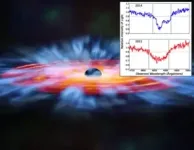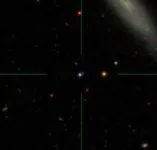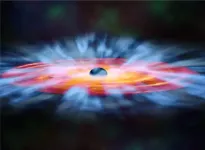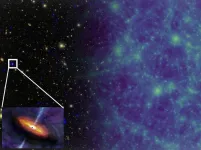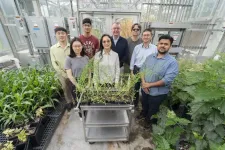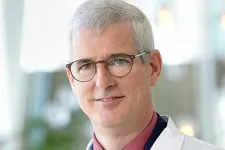(Press-News.org) Chemical engineering professor Dr. Jeetain Mittal has received a National Institutes of Health grant to support his work on phase separation.
Mittal’s research focuses on developing a multiscale computational framework to investigate the role of phase separation in biology, particularly in the formation of heterochromatin. Heterochromatin condensates are membraneless organelles that help control gene expression.
A key aspect of the proposal is the role of phase separation in chromatin organization, highlighting the need for new models in this area. Mittal’s strategy aims to elucidate the molecular origins of phase separation using innovative models and methods tailored to relevant phase separation systems.
According to Mittal, this research could lead to insights into neurodegenerative diseases such as Alzheimer’s disease, Parkinson’s disease, amyotrophic lateral sclerosis (ALS), and frontotemporal dementia. The proposed work aims to develop and utilize multiscale computational methods, from the atomic to the mesoscale level, to build a molecular mechanistic framework.
“In the context of heterochromatin, you're dealing with tightly controlled gene expression,” Mittal said. “This process involves the phase separation of proteins and nucleic acids, which helps form these membraneless compartments.”
Phase separation plays a role in diverse biological processes and can explain longstanding questions related to cellular organization. The first part of the project will focus on the phase separation of RNA-binding proteins and their role in DNA damage repair and transcriptional condensates formed by fusion oncoproteins.
The team aims to decipher the relationships between amino acid sequence, phase behavior, condensate dynamics, and biological function to leverage phase separation for synthetic biology and understanding cellular function and dysfunction.
The second part of the project will provide a detailed molecular picture of phase-separated protein assemblies in chromatin organization, focusing on the co-phase separation of the heterochromatin protein family.
This research changes the way scientists think about biological organization and can predict which biomolecules or proteins will form membraneless organelles. By building and using computer models, the proposal aims to simulate the process of phase separation in a controllable way, expanding the scope of these models.
Mittal believes that a combination of computer modeling and experimental techniques such as NMR, microscopy, and microrheology can provide the best path toward uncovering the relationship between amino acid sequence and phase separation. The ultimate goal is to push the boundaries of what is possible, gaining insights that will help discover new therapies and bridge the gap between macroscopic observations and macromolecular phase separation.
By Raven Wuebker, Texas A&M University Engineering
###
END
Texas A&M researcher receives grant for work on phase separation
Dr. Jeetain Mittal has been announced as the 2024 National Institutes of Health grant recipient for his work with multiscale computational models
2024-06-11
ELSE PRESS RELEASES FROM THIS DATE:
Wind from black holes may influence development of surrounding galaxies
2024-06-11
Clouds of gas in a distant galaxy are being pushed faster and faster — at more than 10,000 miles per second — out among neighboring stars by blasts of radiation from the supermassive black hole at the galaxy’s center. It’s a discovery that helps illuminate the way active black holes can continuously shape their galaxies by spurring on or snuffing out the development of new stars.
A team of researchers led by University of Wisconsin–Madison astronomy professor Catherine Grier and recent graduate Robert Wheatley revealed the accelerating gas using years of data collected from a quasar, a particularly ...
Impact Journals sponsors 2024 Ride for Roswell
2024-06-11
Impact Journals is thrilled to sponsor Team Open Access again in the annual cycling event to end cancer, The Ride for Roswell, on June 22, 2024.
BUFFALO, NY- June 11, 2024 – The Ride for Roswell is one of the nation’s largest cycling events—hosted by Roswell Park Comprehensive Cancer Center—to raise awareness and funds for cancer research and patient care. This charity bike ride, based out of Buffalo, New York, has brought people together for 28 years to celebrate cancer survivors, pay tribute to lives that have been lost, and to work together to support research and find a cure.
THE ORIGIN OF THE RIDE
The Ride for Roswell started ...
Safer virus helps eliminate cancer
2024-06-11
· Weakened virus helps eliminate melanoma and colon cancer in mice
· Therapy is effective in treating and even preventing cancer
· Virus raises ‘red flag’ on tumors so immune cells know to attack it
CHICAGO --- Northwestern Medicine scientists have discovered that an attenuated (weakened) virus can help eliminate cancer in mice. In addition, mice that were treated with this virus were more resistant to developing tumors later in life.
The attenuated virus — lymphocytic ...
Mizzou scientists spot more Milky Way-like galaxies in early universe
2024-06-11
University of Missouri scientists are peering into the past and uncovering new clues about the early universe. Since light takes a long time to travel through space, they are now able to see how galaxies looked billions of years ago.
In a new study, the Mizzou researchers have discovered that spiral galaxies were more common in the early universe than previously thought.
“Scientists formerly believed most spiral galaxies developed around 6 to 7 billion years after the universe formed,” said Yicheng Guo, an associate professor in Mizzou’s ...
How do supermassive black holes get super massive?
2024-06-11
UNIVERSITY PARK, Pa. — By combining forefront X-ray observations with state-of-the-art supercomputer simulations of the buildup of galaxies over cosmic history, researchers have provided the best modeling to date of the growth of the supermassive black holes found in the centers of galaxies. Using this hybrid approach, a research team led by Penn State astronomers derived a complete picture of black-hole growth over 12 billion years, from the Universe’s infancy at around 1.8 billion years old to now at 13.8 billion years old.
The research comprises two papers, ...
Pilot study in JNCCN explores new approach for reducing anxiety and improving quality of life after stem cell transplantation
2024-06-11
PLYMOUTH MEETING, PA [June 11, 2024] — New research in the June 2024 issue of JNCCN—Journal of the National Comprehensive Cancer Network highlights a promising approach for alleviating distress, enhancing quality of life, improving physical function, and reducing fatigue in patients with blood cancers who undergo hematopoietic stem cell transplantation (HSCT). The study used a randomized clinical trial to evaluate the feasibility of a nine-week, phone-delivered, positive psychology program called Positive Affect for the Transplantation of ...
Controlling the precise timing of electrical pulses may offer promise for treating mild traumatic brain injury
2024-06-11
An awkward beat doesn't help on the dance floor, but it could help people who are recovering from mild traumatic brain injury (mTBI).
Publishing online today (June 11, 2024) in the Journal of Neurotrauma, Virginia Tech scientists with the Fralin Biomedical Research Institute at VTC show that specifying the timing pattern of neurostimulation – impulses used to activate the brain’s own electrical signaling mechanisms – can rebalance the strength of synaptic connections between nerve cells, selectively up- or down-regulating those connections. While the timing pattern of electrical signaling is important in the normal brain, ...
Scientists engineer yellow-seeded camelina with high oil output
2024-06-11
UPTON, N.Y. — Efforts to achieve net-zero carbon emissions from transportation fuels are increasing demand for oil produced by nonfood crops. These plants use sunlight to power the conversion of atmospheric carbon dioxide into oil, which accumulates in seeds. Crop breeders interested in selecting plants that produce a lot of oil look for yellow seeds. In oilseed crops like canola, yellow-seeded varieties generally produce more oil than their brown-seeded counterparts. The reason: The protein responsible for brown seed color — which yellow-seeded plants lack — also plays a key role in oil production.
Now, plant biochemists at the U.S. Department of Energy’s (DOE) Brookhaven ...
Specialist and migratory birds at greater risk under climate change
2024-06-11
URBANA, Ill. -- Following decades of decline, even fewer birds will darken North American skies by the end of the century, according to a new analysis by scientists at the University of Illinois Urbana-Champaign. Their study is the first to examine the long-term effects of climate change on the abundance and diversity of bird groups across the continent as a whole while accounting for additional factors that put birds at risk, such as pesticides, pollution, land use change, and habitat loss.
“Many studies try to attribute causes like climate ...
New biomarker database designed to improve astronaut health may also be useful to earthlings
2024-06-11
As space travel becomes more frequent, a new biomarker tool was developed by an international team of researchers to help improve the growing field of aerospace medicine and the health of astronauts.
Dr. Guy Trudel (Professor in the Faculty of Medicine), Odette Laneuville (Associate Professor, Faculty of Science, and Director of the Biomedical Sciences) and Dr. Martin Pelchat (Associate Professor in the Department of Biochemistry, Microbiology and Immunology) are among the contributors to an international ...
LAST 30 PRESS RELEASES:
Making lighter work of calculating fluid and heat flow
Normalizing blood sugar can halve heart attack risk
Lowering blood sugar cuts heart attack risk in people with prediabetes
Study links genetic variants to risk of blinding eye disease in premature infants
Non-opioid ‘pain sponge’ therapy halts cartilage degeneration and relieves chronic pain
AI can pick up cultural values by mimicking how kids learn
China’s ecological redlines offer fast track to 30 x 30 global conservation goal
Invisible indoor threats: emerging household contaminants and their growing risks to human health
Adding antibody treatment to chemo boosts outcomes for children with rare cancer
Germline pathogenic variants among women without a history of breast cancer
Tanning beds triple melanoma risk, potentially causing broad DNA damage
Unique bond identified as key to viral infection speed
Indoor tanning makes youthful skin much older on a genetic level
Mouse model sheds new light on the causes and potential solutions to human GI problems linked to muscular dystrophy
The Journal of Nuclear Medicine ahead-of-print tip sheet: December 12, 2025
Smarter tools for peering into the microscopic world
Applications open for funding to conduct research in the Kinsey Institute archives
Global measure underestimates the severity of food insecurity
Child survivors of critical illness are missing out on timely follow up care
Risk-based vs annual breast cancer screening / the WISDOM randomized clinical trial
University of Toronto launches Electric Vehicle Innovation Ontario to accelerate advanced EV technologies and build Canada’s innovation advantage
Early relapse predicts poor outcomes in aggressive blood cancer
American College of Lifestyle Medicine applauds two CMS models aligned with lifestyle medicine practice and reimbursement
Clinical trial finds cannabis use not a barrier to quitting nicotine vaping
Supplemental nutrition assistance program policies and food insecurity
Switching immune cells to “night mode” could limit damage after a heart attack, study suggests
URI-based Global RIghts Project report spotlights continued troubling trends in worldwide inhumane treatment
Neutrophils are less aggressive at night, explaining why nighttime heart attacks cause less damage than daytime events
Menopausal hormone therapy may not pose breast cancer risk for women with BRCA mutations
Mobile health tool may improve quality of life for adolescent and young adult breast cancer survivors
[Press-News.org] Texas A&M researcher receives grant for work on phase separationDr. Jeetain Mittal has been announced as the 2024 National Institutes of Health grant recipient for his work with multiscale computational models

